Identifying tree seed pods is a fascinating and essential skill for nature enthusiasts and botanists. Seed pods are a key feature in distinguishing tree species, offering clues about their origin and growth habits. This guide explores various types, shapes, and sizes of seed pods, providing detailed insights and expert tips for accurate identification. Whether you’re exploring forests, urban parks, or your backyard, this comprehensive resource will help you unlock the secrets of tree seed pods and their ecological significance.
Overview of Tree Seed Pods
Tree seed pods are diverse structures that house seeds, varying greatly in shape, size, color, and texture. They can be winged, legume-like, or cone-shaped, serving as vital identifiers for tree species. Seed pods protect seeds during development and play a crucial role in dispersal, ensuring the survival of tree populations. From samaras to catkins, each type reflects evolutionary adaptations to environmental conditions. Understanding these structures is essential for ecological studies, reforestation efforts, and appreciating biodiversity. Modern techniques, such as drone planting, highlight their significance in conservation and habitat restoration, making seed pods a cornerstone of botanical exploration and environmental stewardship.
Importance of Seed Pods in Tree Identification
Seed pods are indispensable for identifying tree species, as their unique shapes, sizes, colors, and textures provide distinct clues. They often remain on trees longer than leaves, aiding year-round identification. For example, maple trees produce helicopter-like samaras, while elm trees yield small, round pods. These structures also reveal ecological roles, such as seed dispersal mechanisms. Understanding seed pods helps in distinguishing similar species and aids in reforestation efforts. Additionally, recognizing toxic pods, like those from certain ornamental trees, is crucial for safety. Seed pods thus serve as a vital link between tree identification, environmental conservation, and practical applications in botany and ecology;
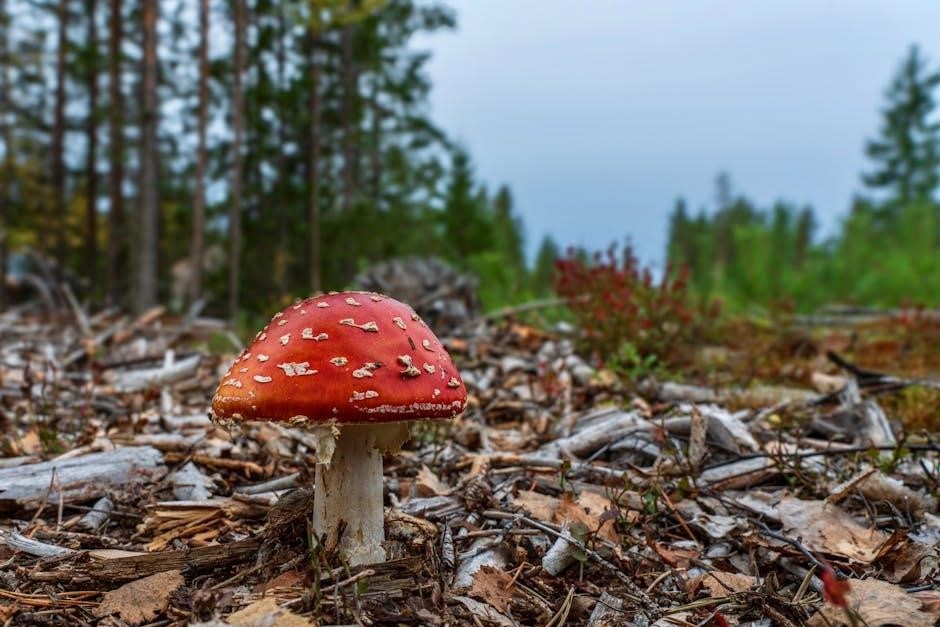
Types of Tree Seed Pods
Tree seed pods vary wildly in form and function, from samaras and legumes to cones and catkins. Each type offers unique characteristics for identification and ecological roles.
Common Types of Seed Pods
Tree seed pods come in various forms, each with unique characteristics. Samaroid pods, like those from maples, have winged seeds for wind dispersal. Legume pods, such as from locust trees, split open to release seeds. Conifer cones, found on pines and firs, protect seeds until they mature. Catkins, like those on birches, are pendulous and produce small seeds. Other types include follicles, capsules, and nuts. Each pod type reflects the tree’s evolutionary adaptations, aiding in seed dispersal and survival. Understanding these common types enhances identification and appreciation of tree diversity in different ecosystems.
Samaras: Winged Seed Pods
Samaras are a unique type of seed pod characterized by their winged structure, designed for efficient wind dispersal. These pods consist of a seed attached to a flattened, wing-like appendage, which creates lift as they fall. Common examples include maple trees (Acer spp.), whose samaras are often called “helicopter seeds” due to their spinning motion. Ash trees (Fraxinus spp.) also produce samaras, though their wings are narrower. The wing’s shape and size determine how far the seed can travel, aiding in colonization of new areas. This adaptation is crucial for spreading seeds away from the parent tree, enhancing survival rates.
Legumes: Pod Characteristics
Legumes are elongated seed pods that split into two halves, revealing a row of seeds inside. They are commonly found on leguminous trees like mimosa and locust. These pods are typically leathery in texture and range in color from green to brown as they mature. Some species have spiny or warty surfaces, while others are smooth. The pods vary in size, from a few centimeters to over a foot long. When mature, they often split open, releasing the seeds. Legumes are a key feature for identifying certain tree species, as their shape, size, and seed arrangement are distinct and diagnostic.
Cones: A Unique Seed Pod Type
Cones are a distinctive seed pod type, primarily found on coniferous trees like pines, spruces, and firs. They develop from reproductive structures and consist of overlapping scales that protect the seeds. Cones vary in size, from small, berry-like structures to large, woody pods. Pinecones, for example, are prominent and woody, while fir cones are upright and disintegrate at maturity. Cones can be oval, cylindrical, or globular, with colors ranging from green to brown. Their texture and scale arrangement are key identifiers for tree species. Cones play a vital role in seed dispersal, often opening to release seeds when mature.
Catkins: Long, Hanging Seed Pods
Catkins are elongated, hanging seed pods typically found on trees like birch, alder, and hazelnut. They are cylindrical or tapering clusters of tiny flowers and seeds, often drooping from branches. Catkins are usually brown or yellowish, with a soft, fuzzy texture. They grow in clusters and are an essential part of a tree’s reproductive cycle. Catkins are often mistaken for cones but lack the hard, scale-like structure. They are a key identifier for certain tree species and play a role in wind pollination. Observing their length, color, and attachment can aid in accurate identification.
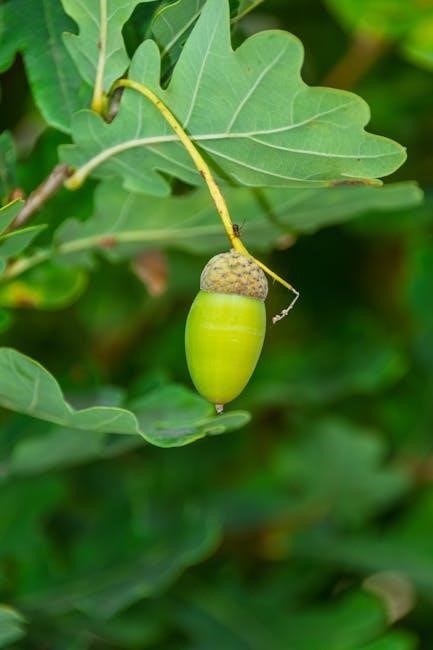
Key Features for Identification
Key features include shape, size, color, texture, and attachment to the tree. These characteristics help distinguish species and understand their ecological roles effectively.
Shape and Size of Seed Pods
Seed pods vary widely in shape and size, providing critical clues for identification. Some pods are elongated, while others are spherical or cylindrical. Size can range from tiny, like those of maple trees, to large, such as acacia pods. Shape often reflects the tree’s evolutionary adaptations, such as spiraled pods for dispersal or spiny textures for protection. Observing these traits helps narrow down species identification, as each tree family exhibits unique pod morphology. For example, chestnut pods are spiny and globular, differing from the flattened pods of ash trees.
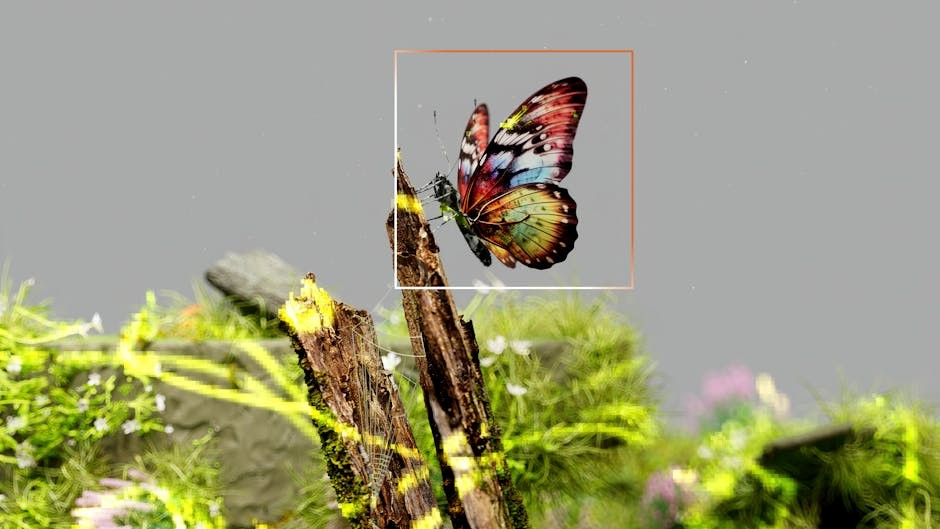
Color Variations in Seed Pods
Seed pods display a wide range of colors, from green to brown, and sometimes red or yellow. These colors often signal stages of development or specific species traits. Immature pods are typically green, while mature ones may turn brown or other hues. Some pods, like those of maple trees, display striking red or yellow shades to attract seed dispersers. Color variations can also indicate environmental factors or genetic differences. Observing these traits helps in distinguishing between species, as certain colors are characteristic of particular tree families. This visual cue is invaluable for accurate seed pod identification.
Texture and Surface Characteristics
The texture and surface of seed pods are critical for identification. Some pods are smooth and glossy, while others are spiny, warty, or covered in fine hairs. For example, maple seed pods are smooth, whereas beech pods often have spiny surfaces. Surface patterns, such as ridges or veins, can also provide clues. Environmental factors may influence texture, but inherent traits remain consistent. Examining these details helps distinguish species, as texture and surface features are often unique to specific tree families. This characteristic, combined with shape and color, enhances the accuracy of seed pod identification in the field.
Attachment to the Tree
The way seed pods attach to the tree is a key identifier. Some pods are attached via short stalks, while others are sessile, meaning they grow directly on the branch. The angle of attachment also varies, with some pods hanging straight down and others growing upright. Stalk length and thickness can differ significantly between species. For example, maple pods often have long, slender stalks, while pine cones are firmly attached with minimal stalks. Observing how pods are positioned and secured to the tree can provide crucial clues for accurate identification and differentiation between similar species.
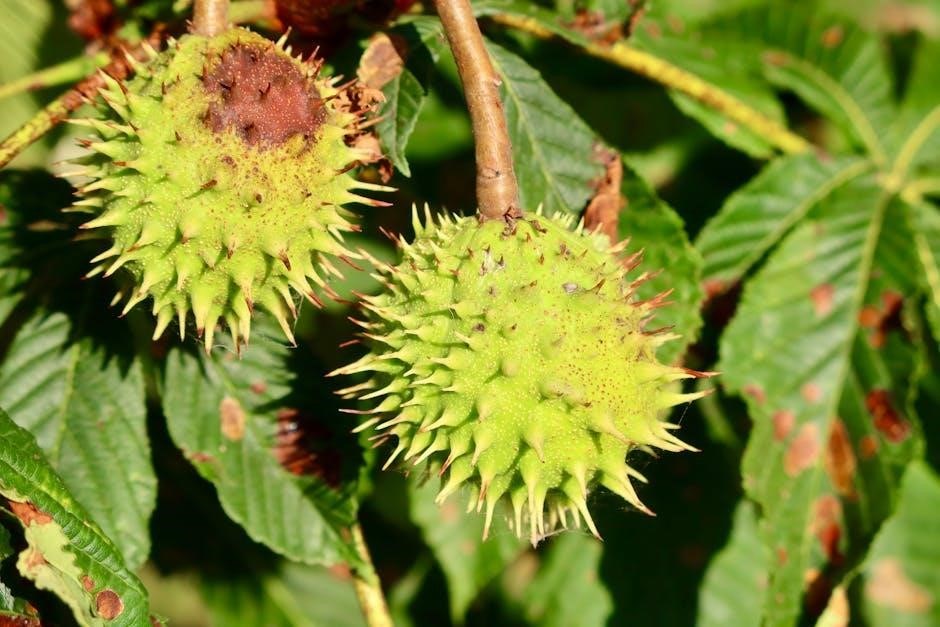
Practical Tips for Identifying Seed Pods
Examine seed pods carefully, noting shape, size, color, and texture. Use field guides, online databases, and expert resources for accurate identification. Observe seasonal changes and tree species associations to narrow down possibilities. Collect samples responsibly and compare with known examples. Practice regularly to build familiarity with different seed pod characteristics and improve identification skills over time. Patience and thorough observation are essential for successful seed pod identification and tree species recognition in various environments.
Observing Seed Pods in Different Seasons
Seed pods undergo noticeable changes throughout the year, making seasonal observation crucial for identification. In spring, pods often form and develop, while summer sees ripening and color changes. Fall is prime for dispersal, with pods opening or changing hues to signal maturity. Winter pods may remain on trees, offering clues even in colder months. Observing these cycles helps identify species, as some pods persist year-round while others fall early. Seasonal variations in color, texture, and structure provide vital clues for accurate seed pod identification and tree species recognition in diverse environments.
Using Field Guides and Online Resources
Field guides and online resources are essential tools for identifying tree seed pods. Detailed descriptions, high-quality images, and comparison charts help narrow down species. Online databases, such as plant identification apps, allow users to upload photos for analysis. Field guides often include regional information, making them invaluable for local species. Cross-referencing multiple sources ensures accuracy. Additionally, botanical websites and forums provide insights from experts and enthusiasts. Leveraging these resources enhances identification skills and broadens knowledge of seed pod diversity, making them indispensable for both beginners and experienced botanists in their identification journeys.
Comparative Analysis with Known Species
Comparative analysis with known species is a powerful method for identifying tree seed pods. By examining similarities and differences, such as shape, size, color, and texture, you can narrow down possibilities. Collecting and studying seed pods from verified trees or using reference photographs can aid in accurate identification. This approach also helps in understanding evolutionary adaptations and ecological roles. Regular practice and documentation enhance skills, making it easier to recognize patterns and unique features. Comparative analysis fosters a deeper connection with tree species and their seed pod characteristics, enriching the identification process with hands-on experience and observation.
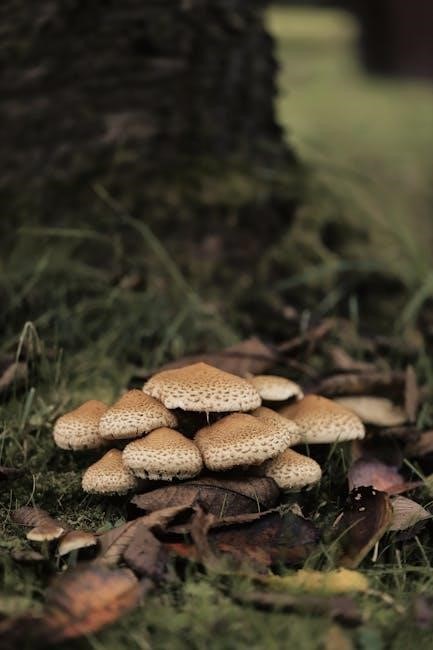
Common Trees and Their Seed Pods
Common trees like maple, oak, and pine produce distinct seed pods, aiding identification. Maple’s samaras, oak’s acorns, and pine’s cones showcase unique features for recognition.
Maple Trees: Helicopter Seeds
Maple trees produce distinctive seed pods known as samaras, often called “helicopter seeds.” These seeds are equipped with a wing-like structure, allowing them to spin and disperse widely. The samaras are typically paired, with each seed attached to a flat, papery wing. They vary in size and color, ranging from light brown to reddish hues. The unique spinning motion aids in spreading the seeds across different terrains. This adaptation ensures genetic diversity and efficient colonization of new areas. Identifying maple trees by their samaras is straightforward due to their iconic shape and behavior during dispersal.
- Key Features: Paired seeds, winged structure, spinning motion.
- Ecological Role: Enhances seed dispersal and forest regeneration.
Elm Trees: Small, Round Seed Pods
Elm trees produce small, round seed pods that are typically light green to tan in color. These pods have a papery texture and contain a single seed. They grow in clusters and often have a notched tip at the top. The pods are an essential food source for various wildlife, including birds and insects. Understanding their life cycle is important for identification, as they appear in spring and may stay on the tree for several months. Their small size and rounded shape make them distinct from other seed pods.
- Key Features: Small size, round shape, light color, papery texture.
- Ecological Role: Provides sustenance for wildlife and aids in elm tree reproduction.
Ash Trees: Winged Seed Pods
Ash trees produce winged seed pods, also known as samaras, which are elongated and narrow. These pods have a single seed at the base and a papery wing extending from one side. The wing aids in wind dispersal, allowing the seeds to travel farther. Ash seed pods typically range in color from green to tan and are often clustered on the tree. They are an essential part of ash tree reproduction and provide a food source for wildlife. Identifying these winged pods can help distinguish ash trees from other species with similar foliage.
- Key Features: Elongated shape, winged structure, single seed, clustered growth.
- Ecological Role: Facilitates seed dispersal and supports local ecosystems.
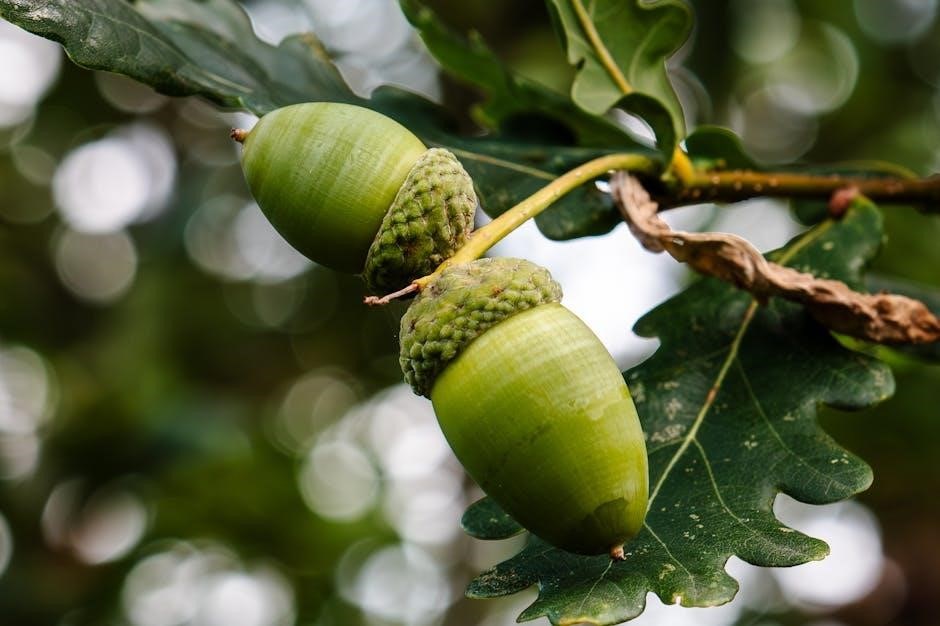
Silver Birch: Catkin Seed Pods
Silver birch trees produce catkin seed pods, which are long, drooping structures that appear in early spring. These catkins are typically pale yellow or brown and grow in clusters. Each catkin contains numerous small seeds surrounded by scales. The pods are slender and cylindrical, measuring several centimeters in length. After releasing their seeds, the catkins often remain on the tree for a time. Silver birch catkins are a key identifier for the species and play a vital role in their reproductive cycle, attracting pollinators and dispersing seeds effectively.
- Key Features: Long, drooping clusters, pale colors, cylindrical shape.
- Ecological Role: Supports pollination and seed dispersal in ecosystems.
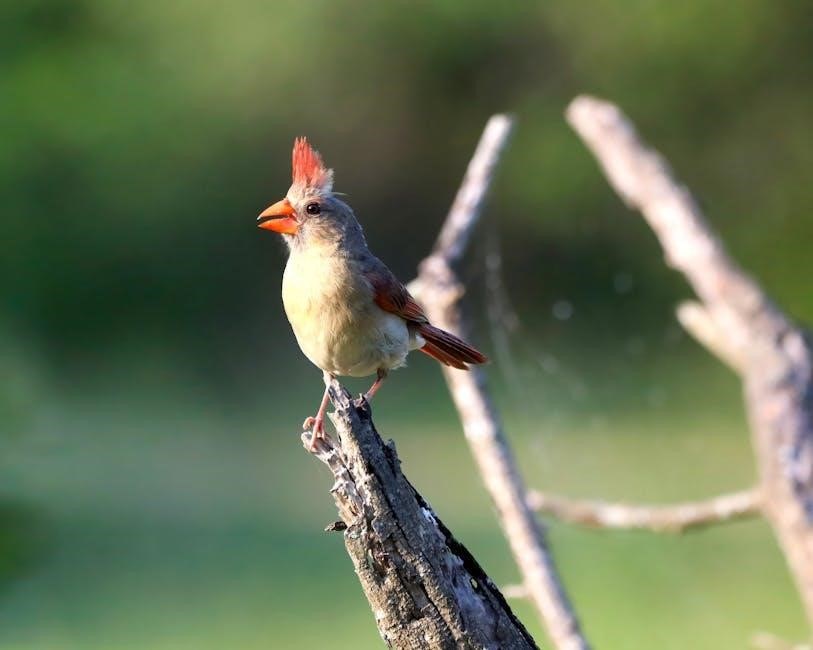
Beech and Chestnut: Spiny Seed Pods
Beech and chestnut trees are known for their spiny seed pods, which provide protection for the seeds inside. Beech seed pods, or cupules, are small, brown, and covered in sharp spines, splitting open to reveal the edible seeds. Chestnut pods are larger, with thicker, more robust spines, and often contain multiple seeds. Both types of pods cling to the tree until maturity, when they fall to the ground. These spiny structures are crucial for seed protection and dispersal, making them a distinctive feature for identification.
- Key Features: Spiny exterior, protective function, variable sizes.
- Ecological Role: Ensures seed survival and aids in forest regeneration.
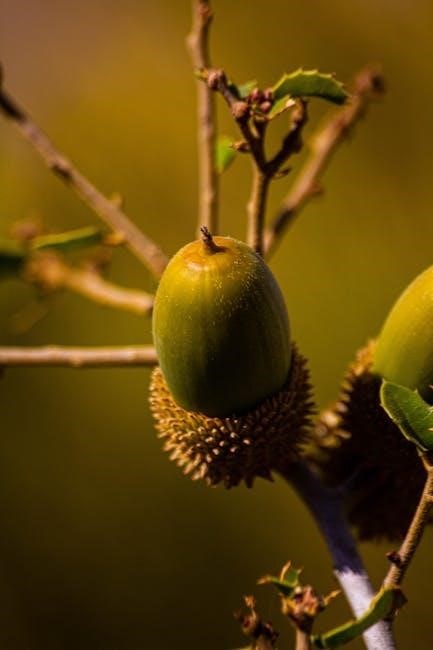
Seed Pods in Different Environments
Seed pods adapt to various environments, thriving in forests, urban areas, and specific regions, influenced by local climate, competition, and species diversity.
Seed Pods in Forests
In forest ecosystems, seed pods play a vital role in tree reproduction and biodiversity. Coniferous trees like pines produce cones, while broadleaf species such as oaks and maples develop diverse seed pods. These structures adapt to forest conditions, ensuring seed survival and dispersal. The shaded, humid environment fosters growth and protects pods from extreme weather.
Identifying forest seed pods involves observing their shapes, sizes, and attachment methods. For example, pine cones are woody and resinous, while maple seeds form winged samaras. Understanding these characteristics helps in recognizing species and their ecological roles within the forest habitat.
Seed Pods in Urban Areas
Seed pods in urban areas often thrive on trees adapted to human-dominated landscapes. Species like maple, elm, and ash are common, producing pods that withstand pollution and limited space. Urban seed pods may be smaller or more compact due to environmental pressures. They still serve ecological roles, providing food for wildlife and aiding in dispersal. Observing their shapes, colors, and textures helps in identification. For example, maple trees produce samaras, while elm trees yield small, round pods. These pods contribute to urban biodiversity despite challenges like heat islands and reduced green spaces.
Seed Pods in Specific Regions (e.g., Florida)
Seed pods in specific regions like Florida exhibit unique characteristics due to the local climate and ecosystems. Mangrove trees, for instance, produce seed pods that can float, aiding in water-based dispersal. Palms, abundant in Florida, often have distinct seed pods that vary in shape and size. Cypress and tupelo trees also display region-specific seed pod adaptations. The warm, humid environment influences pod development, with some species evolving water-resistant or buoyant features. Observing these regional adaptations is key to accurate identification, as they differ significantly from pods found in cooler or drier climates.
Ecological Role of Seed Pods
Seed pods are vital for ecosystem sustainability, enabling seed dispersal and forest regeneration. They provide nutrients and support biodiversity, playing a crucial role in maintaining healthy ecosystems and wildlife habitats.
Seed Dispersal Mechanisms
Seed pods play a crucial role in seed dispersal, ensuring the survival of tree species. Wind, water, and animals are primary dispersal agents. Some pods, like samaras, have wings that allow seeds to glide through the air, while others, such as legumes, split open explosively to scatter seeds. Water-dispersed pods, like those of coconut palms, float to new locations. Animals often consume seeds, later depositing them in new areas with natural fertilizer. These mechanisms enhance genetic diversity and colonization of new habitats, making seed pods indispensable for ecosystem balance and biodiversity.
Role in Reforestation Efforts
Seed pods are essential for reforestation, as they provide the genetic material needed to grow new trees. Conservation efforts often focus on collecting and planting seeds from pods, ensuring genetic diversity and resilience. Seed pods help identify suitable species for specific environments, promoting successful reforestation. They also enable the restoration of degraded habitats by providing native tree species adapted to local conditions. Additionally, seed pods contribute to soil health through nutrient cycling, supporting the growth of new saplings. Their role in large-scale planting projects underscores their importance in sustaining ecosystems and combating deforestation.
Impact of Seed Pods on Ecosystems
Seed pods significantly influence ecosystems by providing food for wildlife, such as birds, mammals, and insects. They contribute to biodiversity by sustaining various species that rely on them for nutrition. Seed pods also play a role in nutrient cycling, as their decomposition enriches soil. This process supports plant growth and maintains soil health. Furthermore, seed pods aid in forest regeneration by ensuring the spread and germination of tree species. Their presence helps maintain ecosystem balance, fostering a healthy environment for flora and fauna to thrive. This ecological impact highlights their vital role in sustaining natural habitats and promoting biodiversity.
Modern Methods in Seed Pod Identification
Modern methods include advanced imaging, AI-powered apps, and genetic analysis for precise seed pod identification, enhancing accuracy and efficiency in ecological studies and conservation efforts.
Use of Drones in Planting Seed Pods
Drones have revolutionized seed pod planting by enabling efficient and scalable reforestation. These devices can access remote or challenging terrains, planting seed pods with precision. Equipped with GPS, drones ensure optimal spacing and soil conditions for growth. This method reduces labor costs and enhances planting speed, making large-scale projects feasible. Additionally, drones can monitor seed pod germination and growth, providing valuable data for future planting strategies. This technology supports ecological restoration and promotes sustainable forestry practices, making it a vital tool in modern environmental conservation efforts.
Automated Reforestation Techniques
Automated reforestation techniques streamline seed pod planting, enhancing efficiency and scale. Advanced machinery, such as mechanical planters and seeders, can cover vast areas rapidly. These systems often include precision technology to optimize seed placement and soil preparation. Automated methods reduce reliance on manual labor, lowering costs and improving consistency. Some systems incorporate seed pod storage and sorting mechanisms to ensure viability. By integrating with technologies like drones and satellites, automated techniques enable large-scale, data-driven reforestation efforts. This modern approach supports rapid ecosystem restoration and promotes sustainable land management practices globally.
Virtual Publications and Guides
Virtual publications and guides have revolutionized the process of tree seed pod identification. Online databases and digital field guides provide high-resolution images, detailed descriptions, and interactive tools for accurate identification. Mobile apps enable users to upload photos and receive instant species matches. Virtual platforms also offer forums and communities for sharing knowledge and experiences. These resources are accessible anytime, making them invaluable for enthusiasts and professionals alike. They bridge the gap between traditional fieldwork and modern technology, fostering a deeper understanding of tree seed pods and their ecological significance.
Safety and Caution
When identifying tree seed pods, always wear gloves and protective eyewear. Be cautious of toxic species and avoid ingesting unknown pods. Ensure safe handling to prevent accidents.
Toxic Seed Pods and Safety Precautions
Some tree seed pods are toxic and pose serious health risks. For example, yew seed pods contain taxine, which is highly poisonous if ingested. Similarly, castor bean pods and black locust pods can cause severe poisoning. Always wear gloves when handling unknown pods to avoid skin irritation or allergic reactions. Keep children and pets away from seed pods, as accidental ingestion can be dangerous. Wash hands thoroughly after handling any seed pods. Never taste or consume unknown pods, as some can be fatal. Consult a medical professional immediately if exposure occurs. Use field guides to identify potentially harmful pods and exercise extreme caution during collection or examination.
Allergies and Reactions to Seed Pods
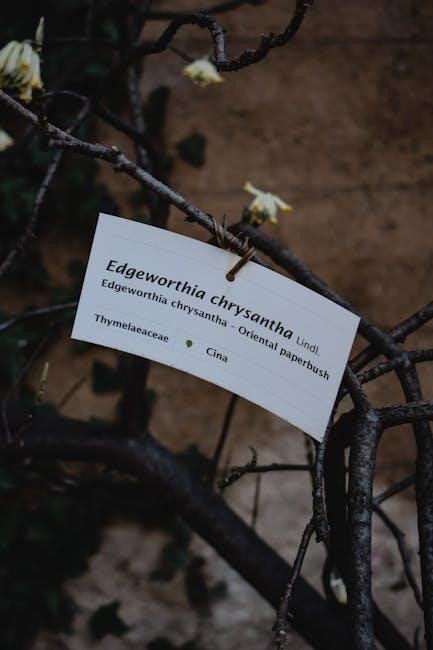
Certain tree seed pods can trigger allergies or cause skin reactions. For instance, birch seed pods produce allergenic pollen that can exacerbate conditions like hay fever. Similarly, grass and ragweed seed pods are known to cause cross-reactivity in sensitive individuals. Some trees, such as cedar and cypress, release pollen from their seed pods that can lead to severe allergic reactions. Symptoms may include sneezing, congestion, or itchy eyes. Handle seed pods with care, especially if you have a history of allergies. Wearing gloves and protective clothing can minimize exposure. If a reaction occurs, consult a healthcare professional for appropriate treatment;
Seed pods are a vital key to tree identification, offering unique insights into species characteristics. By mastering their shapes, sizes, and features, you’ll enhance your botanical skills and deepen your connection with nature. Happy exploring!
Final Thoughts on Seed Pod Identification
Identifying tree seed pods is a rewarding journey that combines observation, knowledge, and curiosity. By understanding their shapes, colors, and textures, you gain insights into a tree’s identity and ecology. Whether in forests, urban areas, or specific regions, seed pods reveal unique stories about their environments. Using field guides, online resources, and comparative analysis can enhance your skills. Remember, seed pods play a crucial role in reforestation and ecosystem balance. Embrace this fascinating world, and let it inspire your next outdoor adventure. Happy exploring, and keep discovering the wonders of nature!
Encouragement for Further Exploration
Exploring the world of tree seed pods is a journey that sparks curiosity and deepens your connection with nature. Each pod tells a story about its tree and environment. Encourage yourself to venture into new habitats, from forests to urban parks, to discover diverse seed pods. Use field guides, apps, and online forums to expand your knowledge. Document your findings and share them with others to inspire a wider appreciation for these natural wonders. Every observation is a step toward becoming a skilled identifier and a guardian of our botanical heritage. Keep exploring—nature has endless surprises in store!
